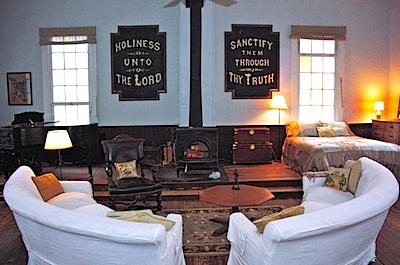Playing and Living in a Church

What child wouldn’t want to have a 1,200-square-foot playhouse? And then, as a grown-up, actually live in it? That is what Molly Ginna did. The house, a former church at the corner of Division and Latham Streets in Sag Harbor, was built in 1897. Ms. Ginna’s mother bought it in the early 1960s, when, as the People’s Baptist Church, it was failing to sustain a congregation and the building was falling into disrepair.
Click to See More Photos
Ms. Ginna’s parents, Margaret Williams Ginna and Robert Emmett Ginna Jr., had a tiny house across the street, and would send their kids and their kids’ friends to play and have sleepovers there. Their own house was too small.
Today, the house is basically one huge, comfortable room. It seems to have just the right amount of privacy and coziness, but it also has enough room for a dancing party. Ms. Ginna, whose stage name is Molly McKenna, inherited the house in 2004, and she and her husband, Chris Plock, have made only a few changes since then.
The space is arranged with a daybed and desk as a study in the left-hand corner just inside the original double-door entryway. A small bookcase and the church’s lectern, now the resting place for a big dictionary, separate the study from the dining area. Two chairs, which Ms. Ginna and her husband call bishop’s chairs,, sit at either end of the table.
The glass panes of the original windows, 12 of them, are stained in different colors. They help define the room as a former church, as do two pews. Ms. Ginna said one of their former tenants had a refectory table built from old barn wood so the pews could be used for seating. It is 9 feet long and about 31/2 feet wide.
Other relics of the church remain. Inscriptions on the wall above, and at either side of, where the lectern once stood are from the Old Testament: “Sanctify Them Through Thy Truth” and “Holiness Unto the Lord.” They were painted onto the wall and frames placed around them. A Dutch West wood-burning stove takes the place of the lectern now, its chimney rising between the inscriptions.
In front of the stove and facing the Bible quotations is a sitting area, with two curved sofas, which Ms. Ginna’s mother bought at Nielsen’s second-hand furniture barn in Southampton. They are slipcovered in white, over 1970s orange chintz.
Another table sits within easy reach of the sofas. A couple of armoires fill out the house. One has been there as long as Ms. Ginna remembers; the other is Austrian, made in the late 1800s and painted a hot, deep pink inside with portraits of cavalry officers on the outside.
The master sleeping area, in the back right corner, and a baby grand piano made by Fischer in New York City in the back left corner, are on the slightly raised platform below the Bible lines at the back of the building, which was actually the front of the church.
To the right of the entrance, taking up the corner, is a line of doors behind which are closets and the bathroom with two original windows and a washer and dryer. The open-plan kitchen, with a small island and a round breakfast table, is behind those enclosures, with a view of the rest of the space.
The couple put in a few ceiling fans a couple of years ago, and have ideas for how the house might be improved. One is to build a loft near the front of the building, which would reveal the triangular window above the entryway, now visible only from the outside. They also think about adding a lower floor in what is now a dirt cellar. Ms. Ginna noted that some of the furniture came from a house her parents once owned in New Hampshire.
Ms. Ginna and Mr. Plock often rent the house in the summer, and anyway, she said, they prefer living there in the winter. “There is no driveway to shovel, I can walk to town, and the light is better at this time of year.”
